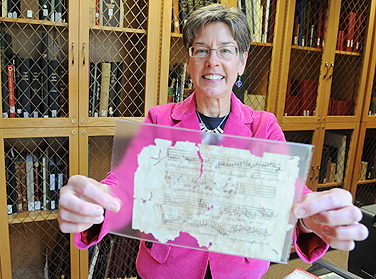Close Up
Nuzzo orchestrates music access

Nancy Nuzzo shows off her favorite treasure from the Music Library’s “Treasure Room”: fragments of 16th century musical transcripts and compositions by composers Josquin, Tromboncino, Festa and Lapicida. Photo: NANCY J. PARISI
-
 Print
Print -
 Comments
Comments
-
“I think everyone realizes that these are wonderful, rich collections that deserve to be known and used and recognized.”
Related links
Nancy Nuzzo has orchestrated tens of thousands of music scores and performances for public access in a vast online concert hall and music repository. She has been leading the Web extension of UB’s Music Library since assuming the directorship 10 years ago upon the retirement of founding directors James Coover and Carol Bradley, who amassed a rich collection of more than 200,000 materials since the library’s beginnings in 1967.
The site is voluminous, with online resources like the Fake Book Index (collections of basic musical lead sheets for performers), Buffalo Musicians, streaming audio that augments the library’s holdings of recordings and indexes to writings about music, printed and manuscript music, and major reference works.
Digital collections began in 2003 through the UBdigit project. The J. Warren Perry Collection of Photographs was the inaugural entry—1,800 vintage photographs of primarily classic opera images dating back to 1910. The link now includes the photo collections of former Department of Music faculty members Leo Smit, Morton Feldman—including those taken of Feldman by Jan Williams—and Yvar Mikhashoff, along with music images from the Pan-American Exposition in 1901 and ballet photos of significant dancers and choreographers in the mid-20th century.
“The music library reflects the strengths of the music department. Historically, their focus has been on contemporary music and the things that we collect reflect that,” says Nuzzo. “We want to provide access to the things that nobody else has that document the history of contemporary music in Buffalo and at UB.”
The engaging Minnesota native has a ready smile and unbounded enthusiasm for her job. She is quick to give credit to her staff members, who have been aggressively expanding the online horizons.
In process is the digitization of reel-to-reel tapes from June in Buffalo and Evenings for New Music concerts recorded in the 1960s on magnetic tape that was in deteriorating condition. “We received a grant to send them out to a vendor with many years of experience in converting converted tapes like this. Our experience with that paved the way for an NEH (National Endowment for the Humanities) grant that the Poetry Collection got this spring to do the same type of reformatting for the large collection of poetry readings—1,300 or so poetry tapes,” she relates.
In 2005, Nuzzo was named director of special collections in the University Libraries, overseeing the Poetry Collection, University Archives and Rare Books along with the Music Library. “At first, I wasn’t quite sure about being in charge of Special Collections, but it didn’t take long to see the connections, the things that we’ve been doing in music that can be applied to Special Collections to raise the level of access to more of the poetry materials,” she says. “There are definitely connections between what we’re doing in all of these areas. It’s a great sharing of expertise.”
She helped coordinate the mounting of a major exhibition of materials from the James Joyce Collection that will be traveling to various sites around the country. The inaugural exhibition is opening this weekend in the UB Anderson Gallery in conjunction with “Eire on the Erie,” the 21st International James Joyce Symposium, co-sponsored by UB, that will take place June 13-17.
“It’s been a really wonderful collaboration between the library, the university art galleries, and the School of Architecture and Planning,” Nuzzo notes. “The students in the school designed the layout of the exhibition and the cases, drew plans to build the cases and helped with the first phase of construction. They drew such a detailed floor plan and elevations that each case shows all of the materials to scale. It’s just been phenomenal and so useful to us in planning this exhibition. I think there is potential for more of this type of collaboration.”
Nuzzo arrived at the Music Library—then in Baird Hall on the South Campus in what is now Allen Hall—in spring 1980. The position was for record cataloger/reference librarian (records as in LPs). A year later, she began the move to the present Baird Hall on the North Campus where the library is located and where physical space is brimming with aisles of books, scores and recordings.
“I think everyone realizes that these are wonderful, rich collections that deserve to be known and used and recognized,” she says.
Outside the library, Nuzzo enjoys playing the viola da gamba, a very sweet, agreeable instrument, as she describes it, a somewhat eccentric version of the cello, which she played earlier (six strings instead of four, underhand rather than overhand bowing and no end pin so it must be held up with one’s leg). She has accompanied student recitals at UB in the past and currently is a member of The York Consort, a quartet that plays chamber concerts of renaissance and baroque music in Buffalo and Toronto.
She lives in Williamsville with her husband, David Nuzzo, budget director for the UB Libraries (yes, they met at UB) and an Iraqi war dog named Zoe, who was rescued and brought to the U.S. by a soldier.
“I love music—it’s like working in a candy store. And it’s been a thrill getting to know the riches and resources of poetry and the archives,” she concludes. “It’s really all about the materials and the staff here—I’m just kind of like the traffic director.”
Or orchestrator.

Reader Comments